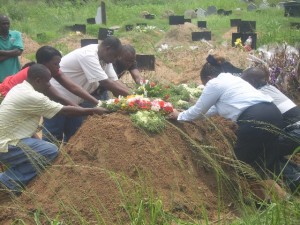
It is an interesting fact that there is nothing in the Zambian school curriculum to prepare the ordinary Zambian for the eventuality of death in the family. There are many Zambians who have no idea what steps to take in the event of death striking at very close range – in their home. I am sure that most of them would like to know how to conduct a funeral that meets society’s expectations.
Some of the questions that they would want to have answers to are:
-
What specific funeral arrangements should one make?
-
How long should the dead person be mourned?
-
Who should be invited to a funeral?
-
What traditional rites should one observe?
-
How much does it cost to conduct a funeral?
The difficulty in finding answers to these questions arises from the fact that the discussion of death and matters related to death is considered unZambian. Zambian culture does not encourage people to plan or prepare for death.
Twenty years ago, a former chief executive officer in a major Zambian parastatal company refused to have the company go into the manufacture of coffins because he could not accept the idea of discussing the subject of death in his board room.
In the more rural areas of Zambia, it is considered taboo to make a coffin if no one has died. A coffin must only be made for a dead person. When my young brother, George, died in Mkushi some ten years ago, we could not find a ready-made coffin to buy. When we enquired why people in Mkushi did not make coffins for sale, we were told that to make a coffin when no one had died was tantamount to inviting death.
The following notes are given as a guide to help people to be prepared for the unexpected moment. The information is based on my observation of funerals in urban areas. For information on how funerals are conducted in a village, you may read Dr. Mwizenga Tembo’s article, “Funerals and Burials in Zambia” at http://people.bridgewater.edu/~mtembo/menu/food/chinaka.shtml.
If a person dies at home, the police have to be informed before taking the body to the mortuary. It is the duty of the police to establish whether the death is a result of natural causes or a result of some foul play.
It is always a good idea to ask some neighbors or close friends to come and help you prepare the home for the funeral gathering. The sitting room needs to be cleared of all property and precious items. The floor of the sitting room is covered by either a carpet or reed mats on which the women will sit during daytime, and spread their blankets at night to sleep.
The settees and dining chairs should all be moved outside for the male folk to sit on. You may need to borrow or hire extra chairs from friends or suitable organizations. You may also need to erect a tent to provide the mourners with a shelter from rain and the sun as the case might be.
The women and girls in the house will usually sit together on the floor and wail in sorrowful tones. This is meant to alert people nearby about the death in the family.
Fire wood is an essential requirement during a funeral. At night, the male mourners sit around the fire to chat up to the early hours of the morning when most of them fall asleep in their chairs before waking up to attend to various duties during the day. There are, however, some, especially relatives of the departed, who remain sitting outside the funeral house for the entire duration of the funeral. Other people come during the day and spend a few hours to give emotional support to the bereaved family.
If you happen to be the person responsible for overseeing the conduct of the funeral, it is necessary for you to sit outside the funeral house together with the other mourners throughout the period of mourning. Your role will be to receive visitors to the funeral house and to answer all pertinent questions regarding different aspects of the funeral.
These days, there are no strict rules about the dressing code during a funeral. Smart casual clothes will do during the days before the burial day. During the day of the burial, it is usual for close family members to be formerly dressed in black suits and dresses.
While physical arrangements are being made for the funeral, you should find time to make a list of people that need to be informed about the death of the concerned person. The list will include close relatives in the village and those overseas as well as close friends and associates of the deceased person. These people should be informed through appropriate means such as phone calls, radio and television messages, emails and newspaper adverts.
You will need to immediately inform the leadership of the church where the deceased person was a member, or your church, in the case where the deceased person did not belong to any church. Arrangements should be made for a church choir to entertain the mourners at night.
The feeding of mourners during the funeral is another critical issue that must be attended to. Enough food should be bought for this purpose, and arrangements made for women to cook and serve the food. Usually, neighbors, workmates, members of the church and other well-wishers make donations in the form of food and money to help the bereaved family meet their various funeral needs. It is important to appoint a responsible member of the family to keep the money and account for its use.
For those departed persons who were at work, there will usually be some assistance given by their former employer in the form of some cash and a coffin to help mourn and bury the late employee. It is, therefore, important to immediately inform the respective company about the death of the employee.
It is a common practice to allow two or three days for mourning in order to afford people from distance places to travel to the funeral and to allow enough time for other administrative arrangements. However, in cases where one or two very close relatives who must attend the burial service are overseas, it may be necessary to wait for five to seven days before the burial service is conducted.
If there are small children in the home that must be protected from the trauma of a Zambian funeral, it may be necessary to arrange for them to stay with some relatives or friends during the period of mourning.
At least a day before the date of burial, you will need to obtain a death certificate from the hospital and a burial permit from the Local Authority. You will also need to pay the appropriate fee for your burial site in the respective graveyard.
Other arrangements that have to be made before the day of burial are as follows:
-
Preparation of the body: If money is available, it is convenient to hire the services of a professional funeral home to prepare the body for burial.
-
Transport arrangements: There is need to hire a hearse or an open van to carry the body, and a big bus, or a number of minibuses, to transport the mourners from the funeral home and the church to the graveyard.
-
Preparation and printing of a funeral programme: The printed funeral programme should indicate the time and place of each activity. The activities will include the following:
-
Church Service
-
Body viewing
-
Laying of wreaths
-
Life History
-
Speeches from the family and respective official
-
Where a postmortem needs to be performed on the body, the funeral programme should be adjusted to accommodate this.
-
It is always a good idea to hire a dedicated still photographer and a video photographer to cover the burial ceremony proceedings.
Early in the morning, on the day of the burial, a few young men should be sent to the graveyard to prepare the grave for the burial. The graves often need to be deepened and broadened to the right dimensions.
Arrangements should also be made for a group of about four women or men, depending on the sex of the deceased person, to go to the mortuary to wash and dress up the body. They will need a set of surgical gloves, a bottle of body lotion, a white bed sheet, a blanket, clothes and a coffin for this purpose. These days, it is possible to pay the mortuary attendant to prepare the body for burial.
There is also need to ask someone to go and buy flowers to place on the grave once it has been completely covered with soil.
If possible, appoint someone to coordinate the transport in order to ensure that everyone is collected at the right time and taken to the church or the graveyard as the case may be. Whether the viewing of the body should be done at the church or at the graveside is a matter of individual choice.
Where a church service is included in the burial programme, the order of the church service is the preserve of the concerned church. At the end of the service, the mourners will get into the vehicles and proceed to the burial site.
Upon arrival at the graveside, the coffin is placed on the side of the grave while the mourners stand or sit around the grave at a reasonable distance. A person appointed as a Master of Ceremonies takes responsibility for guiding the proceedings.
There will usually be an opening prayer by the pastor or a member of the church. If no prior church service has been conducted, the pastor or a member of the church will read a passage from the Bible and preach a short sermon based on the passage.
These days, it is common for one or two family members or close friends of the deceased person to say a poem or a eulogy about the deceased person before the coffin is put into the grave. The relatives of the deceased are then asked to each throw a handful of dust into the open grave before it is filled up with soil.
Where possible, people prefer to place a layer of a mixture of wet sand and cement below the top soil. This is meant to prevent the theft of the coffin by unscrupulous people.
When the soil on top of the grave has been raised to the required height, the Master of Ceremonies calls out names of people to come forward and place flowers on top of the grave.
Speeches from various people follow. The speakers include a representative from the deceased person’s former place of work, a representative of the church, and a member of the deceased family. The family representative briefly thanks the various people and organizations for their various contributions to the success of the burial ceremony.
The pastor or a member of the church then closes the burial session with a prayer, after which all the mourners troupe back to the funeral house. A bucket of water is placed at the entrance of the yard for mourners to wash their hands. It is, however, more hygienic to ask the people to use running water from the tap where this is available.
The mourners sit outside the house for a few minutes as a sign of respect before departing from the funeral house. Those who need meals are provided with some food. A traditional drink of “munkoyo” is usually served to all the mourners.
Usually, close relatives will stay overnight in order to attend a traditional gathering of relatives the next morning at which pertinent issues are discussed and certain traditional rites performed. In Bemba, this is referred to as “Isambwe Lyamfwa.” In some cases, where some important relatives have to leave at the end of the day of the burial, the gathering may take place on the same day.
Issues discussed at the traditional gathering include decisions regarding the welfare of the surviving spouse and children where these exist. There are also decisions regarding the distribution of the deceased person’s clothes and property, and the appointment of an administrator for the deceased estate.
The day after the day of burial, the wood fire is extinguished and the fire place swept clean to symbolize the official end of the formal period of mourning. A few close relatives stay with the bereaved family for a week or so to keep them company.
According to the traditions of some tribes, after the mourning period in town, the spouse of the departed is expected to travel to the village of the deceased person’s relatives to mourn with them for a short period. This practice is referred to as “taking the funeral to the village.”
How much does it cost to conduct a funeral in Zambia?
The cost of conducting a funeral varies according to a number of factors and items involved. The number of people attending a funeral will determine the cost of feeding and transporting them. Another factor will be the duration of the period of mourning.
The following costs apply to most funerals:
-
The cost of transport for the body and for the mourners
-
The cost of food
-
The fee for a burial site
-
The cost of cement and other incidentals.
The cost of the coffin is a significant cost item. Prices of coffins on the market currently range from about K700,000 to about K5,000,000.
It is important to note that in most cases, the cost of conducting a funeral is shared with the community. In the Zambian society, one never mourns alone as the bereavement of one family is regarded as the bereavement of the entire community.
It is my hope that future writers will research more thoroughly into all the facets of conducting a funeral in Zambia and produce more comprehensive guides to the business of funerals. I also hope that the reader will find this attempt of mine helpful in dispelling the general state of ignorance among many Zambians regarding this subject.
______________________________________





A pastor in zambia told me a member of the church died on a thursday morning and they are having her funeral on friday the next day. Is this true? from reading this article it is too fast what about the mourning time? I never heard of anyone in zambia being buried in one day. Please adivse. Thank you
Hi Dorothy,
With the increase in deaths brought on by HIV/AIDS, there has been a change in the way people mourn the dead. There are so many funerals going on that it has become increasingly difficult for people to attend every funeral of people they know. Church choirs move from one funeral to another during the course of the week.
The increasing cost of living has forced families to curtail traditional funeral ceremonies in order to cut down funeral costs.
In the rural areas, there is increasing pressure for burials to be brought forward due to the lack of mortuary facilities.
These and other pressures have increased the tendency for funerals to be conducted as quickly as possible.
Pastors are heavily involved in what is going on in the community. I would be inclined to agree with your pastor friend.
Thank you for taking the time to write this. Very informative.